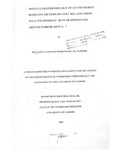| dc.description.abstract | Drug-resistant micro-organisms belonging to the species F-',coli remain a major
health problem worldwide. They are of particular importance in developing
countries where few therapeutic choices are available for treating infections. Few
studies have addressed the epidemiological issues and the dynamics of
antimicrobial resistance genes of E. coli causing disease in these countries.
Antimicrobial resistance in rats as in other animals may have great impact on
human health, particularly in an environment where humans and rats share the
same ecosystem because of the zoonotic nature of E coli infections.
Furthermore, the tendency of rats to contaminate water sources and human food
may lead to concentration of antimicrobial resistant E. coli with subsequent
transmission to humans and other animals. This study was designed to determine
if antimicrobial resistance occurs in E coli isolated from rats living in the vicinity
of human settlements. An attempt was made to determine if the resistance was
encoded on plasmids and if it is transferable from one bacteria to another.
Rats were trapped from inside and outside the houses. E. coli and other members
of the family enterobacteriaceae which included Proteus spp., Enterobacter spp.,
Citrobacter spp., Klebsiella spp., Morganella spp. and Salmonella spp., were
isolated from contents of their gastro-intestinal tracts. Antimicrobial
susceptibility tests were perfomed on E. coli isolates and plasmids isolated from
the E. coli showing resistance. Transferable antimicrobial resistance was
determined by the ill vitro conjugation tests.
Rats were radomly trapped from the densely populated (slums) area of Kibera
and the less densely populated areas of Kawangware and Kabete in Nairobi,
Kenya. The significance of the three areas is that the densely populated areas
have poor sewer systems and dumping sites hence there is high likelihood of
contact between rats and human as opposed to the less densely populated areas.
The proportions of E. coli isolated from rats trapped in Kibera and Kabete areas
did not differ significantly (P=0.5658). The proportions did not also differ
significantly depending on whether rats were trapped from inside or outside the
houses (P=0.8696). Kawangware area was not used in the comparisons as no E.
coli isolates were obtained.
Antimicrobial susceptibility to I I antimicrobials was done using disc diffusion
method. The antimicrobials tested were ampicillin (10 J.1g), co-amoxyclav (20: 10
J.1g), sulphamethoxazole (10 J.1g), streptomycin (10 J.1g), tetracycline (10 J.1g),
trimethoprim (5 ug), cefuroxime (30 J.1g), nalidixic acid (30 J.1g), gentamicin (IO
J.1g), ceftazidime (30 J.1g) and ciprofloxacin (5 J.1g). Twelve (20%) of the 60 E.
coli isolates tested were resistant to a single antimicrobial mainly ampicillin,
streptomycin and sulphamethoxazole. Eight (13.3%) of the isolates showed
multidrug resistance. Eight (13.3%) of the isolates were fully susceptible to all
the I I antimicrobials.
The minimum inhibitory concentrations (MICs) of the 60 I..,..•. coli isolates were
also determined by the doubling agar dilution method. Fourteen (23.3%) of the
isolates were resistant to ampicillin, 9 (15%) to streptomycin, 6 (6.6%) to cotrimoxazole,
2 (3.3%) to tetracycline and I (1.7%) to co-amoxyclav. The MIC50
and MIC<)()were exceptionally low except for ampicillin which were 16 and 64
ug, respectively. Exceptionally high MIC (128 ugunl) was observed for only 2
(3.3%) isolates, one to ampicillin and the other to streptomycin.
There was no significant (P=0.2627) difference between the number of resistant
L'. coli isolates using the MIC or. the disc susceptibility tests. A significant
(P=0.043I ) difference occurred between the number of resistant E coli isolates
from rats trapped in Kibera and Kabete areas but no significant (P=0.2884)
difference occurred between resistant E. coli isolates from rats trapped inside
and outside the houses.
Plasmid profile analysis grouped the 22 antimicrobial resistant E coli into 5
plasmid groups depending on the number of plasmids each isolate carried.
Sixteen (72.7%) of these isolates carried plasmids while 6 (27.3%) did not carry
any plasmids. Plasmids of approximately 90-100 Mda, 55-65 Mda and 40-50
Mda were found at high frequency in resistant isolates and were thought to be
responsible for the resistance.
In conjugation tests, resistance was only transferred from E coli isolates
resistant to ampicillin to E. coli KI2. Five (35.7%) out of the 14 isolates
resistant to ampicillin showed transferable resistance. Three (60%) out of 5
transconjugants carried plasmids while for the other 2 no plasmids were
recovered.
In conclusion, rats may act as a pool of antimicrobial resistant E coli and their
plasmids. These antimicrobial resistant E. coli may be transmitted to humans and
form their normal gastro-intestinal tract microtlora with subsequent transfer of
the resistance to other pathogenic micro-organisms. Further studies are
recommended to determine if any relationships exist between plasmids carried \}y
antimicrobial resistant E. coli isolates from rats, humans and other domestic
animals. | en |

